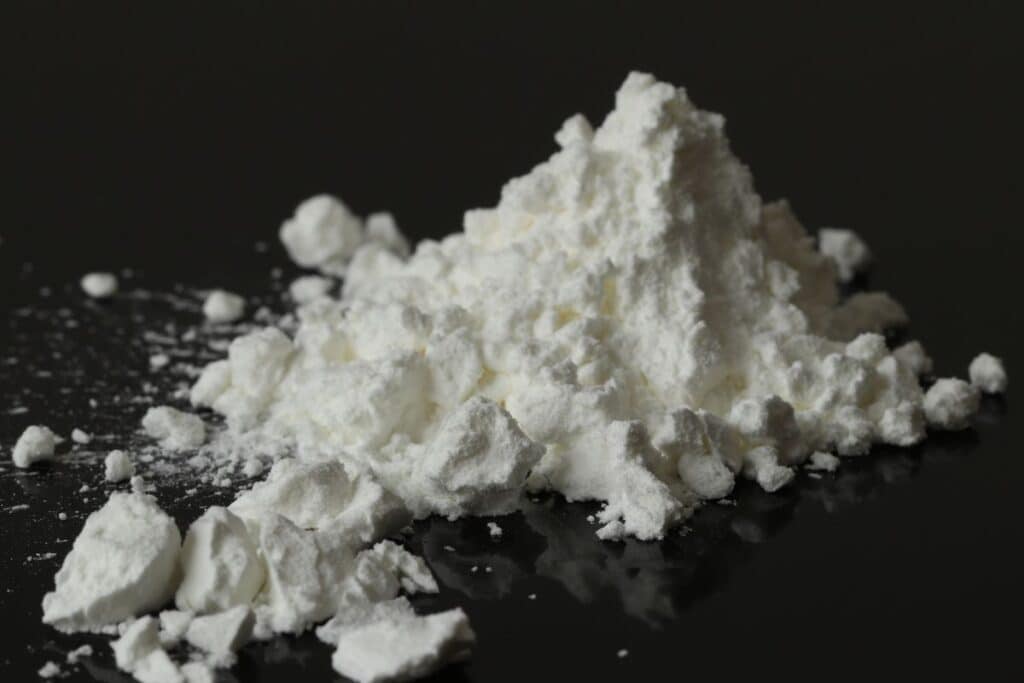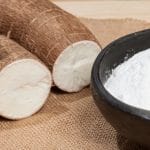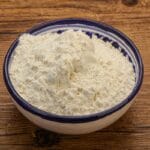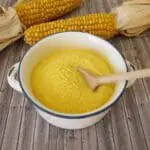Wheat flour, psyllium husk, guar gum, tapioca flour, potato starch, arrowroot starch, and many more can be used as alternatives to cornstarch if you run out or are allergic to it. Each substitute has its properties and recommended quantities, so choose the one that best suits your recipe and dietary needs.
Cornstarch is often a go-to ingredient for thickening all kinds of sweet and savory dishes. Depending on where in the world you live, the product may go by the name of corn flour.
In the US, however, corn flour refers to dried corn ground to a yellow flour. Cornstarch, on the other hand, is made from the white starch-rich endosperm of a corn kernel, ground into a very fine powder.
If you’re out of cornstarch and your soup, gravy, or custard just isn’t coming together, there are a host of alternative thickening agents you can use instead. In this handy guide, we’ll help you choose the best cornstarch substitute suitable for the dish you’re making.
Cornstarch Uses and Properties
Cornstarch is wheat-free and gluten-free, which makes it a great ingredient to thicken sauces, soups, and stews for people who have allergies or suffer gluten intolerance. Unlike wheat flour, it brings a translucent and somewhat shiny appearance when used as a thickener rather than dulling the color of the sauce.
You may be surprised to find that cornstarch is also listed in some dairy product ingredients and is commonly used as an anticaking agent in confectioners’ sugar, spice mixes, and instant soup or sauce powders.
Another common use for cornstarch is coating fried foods such as nuggets and chicken wings, to give them a crispy crust. Less commonly, it is also used in baking. Since it is gluten-free, it is not used in the same way as wheat flour but rather as a small addition to a variety of other flour types.
Best Cornstarch Substitutes
1. Wheat Flour
Unless you are gluten intolerant, wheat flour is probably the easiest and most readily available substitute for cornstarch. However, if you have wheat or gluten allergies, this won’t be a suitable alternative for you.
When using wheat flour as a replacement, it may require a slightly longer time to cook and thicken. You also want to ensure that it is cooked well enough so that you don’t end up with a raw starch taste or pasty texture.
Substitute quantity: Use twice the amount of wheat flour as a replacement for thickening. If your recipe calls for one tablespoon of cornstarch, replace it with 2 tablespoons of white wheat flour.
Tip: Mix the wheat flour with a little cold water and stir it to form a paste before adding to the liquid you are thickening. Stir the liquid as you add it to let it mix through evenly.
Related: Wheat flour replacement
2. Psyllium Husk
Psyllium husks are high in soluble fiber and low in carbs. The plant-based thickening agent can be used in its refined powder form or unrefined form. For thickening liquids, the refined option may yield a smoother, silkier outcome.
Since it has powerful thickening properties, you only need a small amount. Give the husks or powder enough cooking time in the liquid to thicken before adding more. Too much will make your dish end up with a gloopy consistency.
Substitute quantity: Start with just half a teaspoon of psyllium husks and add more slowly if needed.
3. Guar Gum
Guar gum is derived from guar beans. It comes in a white powder form and has intense thickening capabilities. The ingredient is high in soluble fiber and low in calories, although the amount you use is generally minimal.
It is also a good gluten-free substitute and, in some cases, used to improve the texture and shelf life of gluten-free baked items.
Substitute quantity: Since it is such a powerful thickener, start by adding one-quarter of a teaspoon only. If necessary, add a little more at a time until the desired consistency is reached.
4. Tapioca Flour
Tapioca starch is made from the starchy root vegetable, cassava. It’s another good gluten-free option, and although it is available in flour, pearls, or flakes, the powder form is the one you want to use as a cornstarch replacement for thickening. It has a neutral taste which makes it suitable for sweet and savory recipes. In fact, tapioca pearls are often eaten as a dessert.
Substitute quantity: Use 2 tablespoons of tapioca flour to replace 1 tablespoon of cornstarch when thickening sauces, gravies, soups, glazes, puddings, or stews.
Related: Tapioca flour alternative
5. Potato Starch
Potato starch, also called potato flour, is made by releasing the starch content in potatoes and then drying it into a powder form. The powder is white and very fine, similar to cornstarch. It can be mixed with other flours to form a gluten-free blend for baking but cannot be used on its own as baking flour.
As with tapioca flour, it is best used for thickening when used as an ingredient on its own. It has almost no taste, so it can be added to any dish without affecting the flavor profile.
Substitute quantity: Replace in equal measures
Tip: Potato starch thickens and absorbs liquid faster than grain starches. Add it a little later in the cooking process, so it doesn’t break down completely by overcooking.
6. Arrowroot Starch
Similar to other vegetable root flours, arrowroot is gluten-free and flavorless. Arrowroot flour contains a little more fiber than cornstarch and forms a clear gel when mixed with water. This makes it a suitable option for clear thickening liquids, fruit compotes, and pie fillings.
Substitute quantity: Use twice the amount of arrowroot than cornstarch called for in your recipe.
7. Rice Flour
Suitable for sweet and savory dishes, rice flour is used in Asian desserts, rice noodles, batters for deep frying, and soups. When mixed with water, it has a colorless appearance. Together with its powerful thickening ability, this makes it ideal for clear thickening liquids, fruit cobblers, and compotes.
Substitute quantity: Use double the amount of rice flour as a replacement in your recipe. If your recipe calls for 1 teaspoon of cornstarch, use 2 teaspoons of rice flour.
8. Ground Flaxseed
Ground flax seeds or flax meal offer some unique properties and benefits that other starchy thickeners don’t. They have good nutritional value and are known for their digestive benefits due to their high soluble fiber content. The tiny brown seeds can be purchased already ground, or you can buy them whole and grind them yourself.
The powder can be added to batters for deep-fried items or to stews for thickening. Keep in mind that ground flax seeds are dark in color and somewhat gritty, so they will darken the appearance of dishes with a light color and won’t offer the same smooth consistency as cornstarch.
They also have a lovely nutty and earthy flavor, so they may slightly alter the taste of subtly flavored dishes.
Substitute quantity: To replace two tablespoons of cornstarch, mix 1 tablespoon of ground flaxseeds or flax meal with 4 tablespoons of water before adding to your coating batter or liquid.
9. Xanthan Gum
Xanthan gum is made by a process that involves the fermentation of simple sugars. Although its name refers to it as ‘gum,’ it is actually a powder.
The product is used in small amounts as a stabilizer or thickener in both sweet and savory dishes. If you add too much xanthan gum to your dish, you will end up with a slimy consistency, so start with just a small amount and add more gradually if necessary. Although it is not a common pantry staple, it is a handy ingredient to have if you do a lot of gluten free baking.
Substitute quantity: Replace in equal measures
Related: Xanthan gum replacement
10. Glucomannan
Glucomannan is a pure powdered soluble fiber with thickening superpowers. It is derived from konjac plant roots and contains no calories or carbs. When mixed with warm water, it absorbs the liquid to form an odorless and colorless gel.
When using it for thickening, mix it with a little cold water first as it thickens at lower temperatures than other substitutes and will clump together if added to hot liquid in its powdered form. Since it has such strong thickening capabilities, you’ll use much less when using it as a substitute.
Substitute quantity: Replace 2 teaspoons of cornstarch with a quarter teaspoon of glucomannan.
Cornstarch Alternative Measurement Guide
Use the following measurements as a guideline when substituting corn starch. Keep in mind that if you are unsure, it is always best to start with less and add more gradually than to add too much of your substitute and end up with gloop.
- One tablespoon of cornstarch is equivalent to:
- 2 tablespoons of wheat flour
- 1 tablespoon of potato starch
- 2 tablespoons of rice flour
- 2 tablespoons of tapioca flour
- 2 tablespoons of Arrowroot powder
FAQs
Conclusion
Most cornstarch substitutes have a similar white powdery appearance and consistency. Generally, 1 tablespoon of cornstarch is enough to thicken 2 cups of liquid. However, this will, of course, depend on what you are making and how thick the soup, sauce, or pudding needs to be.
Always mix the thickener, regardless of the option you are using, with a little cold water to form a paste before adding it to the hot liquid. Once added, give it enough time to cook and thicken sufficiently before deciding if you need more.
See more: Does cornstarch go bad?
*image by homeworlds/depositphotos









